Sometimes herbal medicine is right in your own backyard, and you often don’t need to go much further than that. But if you venture out to the woods, be sure to collect some conifer needles, as they have benefits that not everyone knows about! Fir needles are especially nice, and can be made into a forest tea with chai spices that is not only delicious and festive, but also helpful for respiratory wellness.
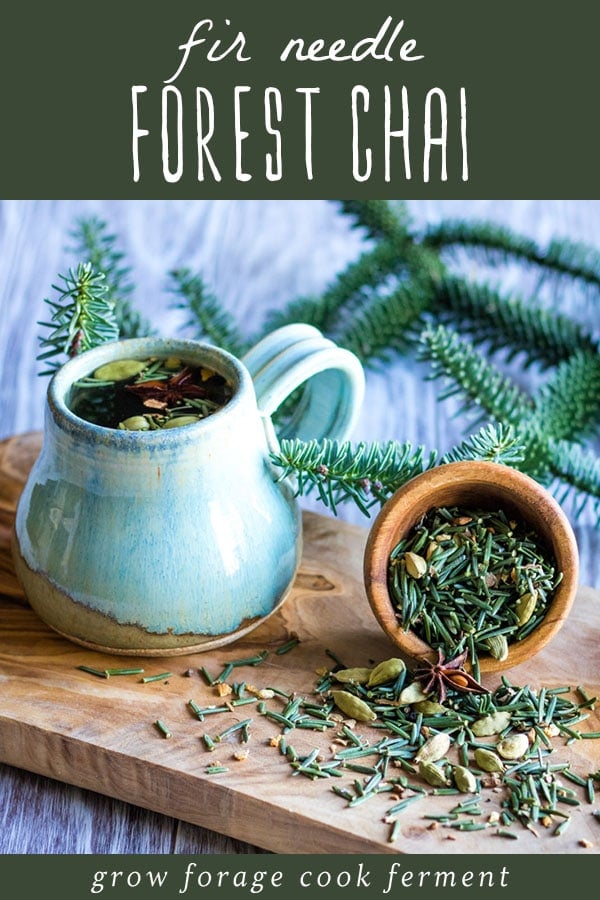
Want to save this post for later?
The Backyard Herbal Apothecary Book
This recipe for Forest-Tea Chai for Respiratory Wellness comes from the wonderful book The Backyard Herbal Apothecary by Devon Young of Nitty Gritty Life.
This book is an amazing resource of inspiring herbal recipes and remedies that can be made from plants that are foraged right from your backyard (or not too far away).
Each plant that is covered in the book has a complete herbal profile, with information on how to forage or grow, harvest, and use, with recipes!
While this fir needle forest chai recipe caught my eye right away, here are some other great sounding recipes from the book:
- Yarrow All-Purpose Wound Salve
- Usnea Dual Extraction Tincture for Respiratory Complaints
- Firming Wild Rose Undereye Cream
This is an excellent book for anyone that is interested in foraging and the healing power of plants!
Devon also has another amazing book called The Herbalist’s Healing Kitchen which is more food focused. They both make great holiday gifts!
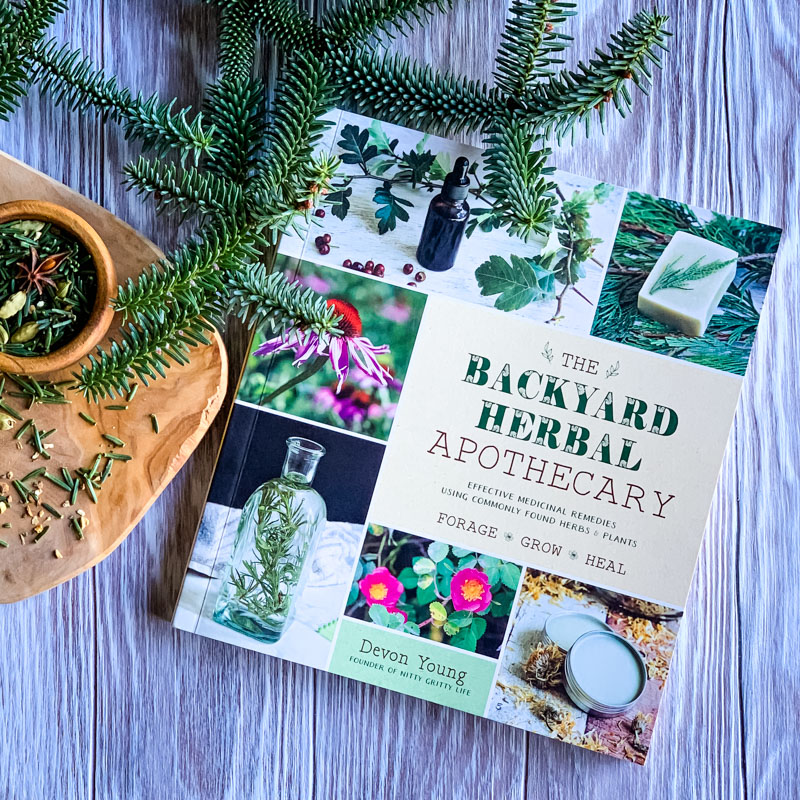
Foraging Fir Needles
Fir needles, just like most foraged conifer needles, are edible and make wonderful medicine!
Fir trees (Abies spp.) are easy to identify from other conifers if you know what to look for. They are very beautiful evergreens that are often used as Christmas trees.
The needles are flat and they attach to the twigs by a base that looks like a tiny suction cup. They also have two white lines on the bottom, and tend to curve upward. The cones stand upright, like candlesticks.
Some common fir species include: grand fir, white fir, silver fir, basalm fir, and noble fir.
Related: How to Identify Conifer Trees: Pine, Fir, Spruce, Juniper & more
Fir Needle Benefits & Uses
Fir needles have many medicinal benefits and are particularly good for the respiratory system. They are anti-inflammatory, antimicrobial. antioxidant, antiseptic, antispasmodic, diuretic, expectorant, and sedative.
I love what Devon says about fir trees in her book The Backyard Herbal Apothecary:
“Firs are known for their aromatic qualities. A hike through an evergreen forest often leaves one feeling restored and invigorated. This sense of rejuvenation is owed to its aromatics. The volatile compounds of the fir needles promote deep, fully actualized breaths and a subtle sedative (think more meditative than sleepy) quality. This “forest therapy” extends beyond the woods and into the apothecary. Fir needles, consumed as a tea or infusion or even applied as an infused oil, speed relief to tight, swollen airways, heavy boggy chests and irritable coughs.”
Because of their respiratory benefits, fir needles would be excellent to use in place of pine needles in my pine needle cough syrup recipe.
Fir needles can be used in any conifer needle recipe. They would be great infused in vodka or used in shortbread cookies for holiday parties.
I think fir needles really shine in this forest chai blend!
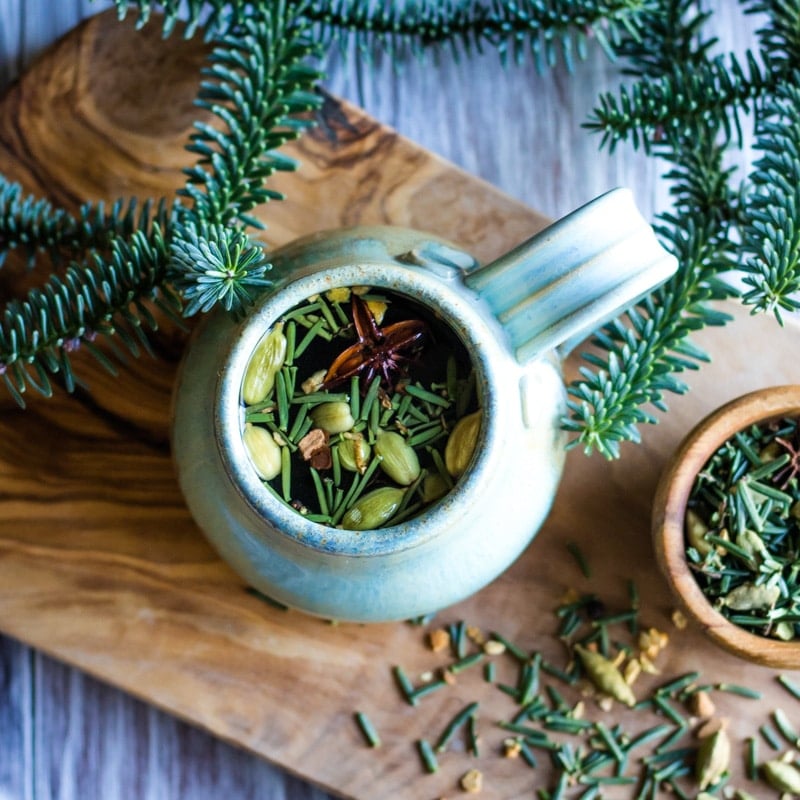
Fir Needle Forest Chai Blend
This recipe is really simple to put together, and is basically just a mix of fir needles with some chai spices. The hardest part of the recipe is collecting the fir needles! It’s good for the soul though.
Once you’ve collected your fir needles, you can either use them fresh or dry them for longer storage.
Because conifer needles have a low water content, it won’t take too long for them to dry. Depending on the humidity level it will only take a week or so.
Simply combine the dried fir needles, dried orange peel, cinnamon chips, cardamom pods, star anise pods, dried ginger pieces, and peppercorns in a jar.
If the fir needles are dry, you can cap the jar and store it in a cool dry place for up to a year.
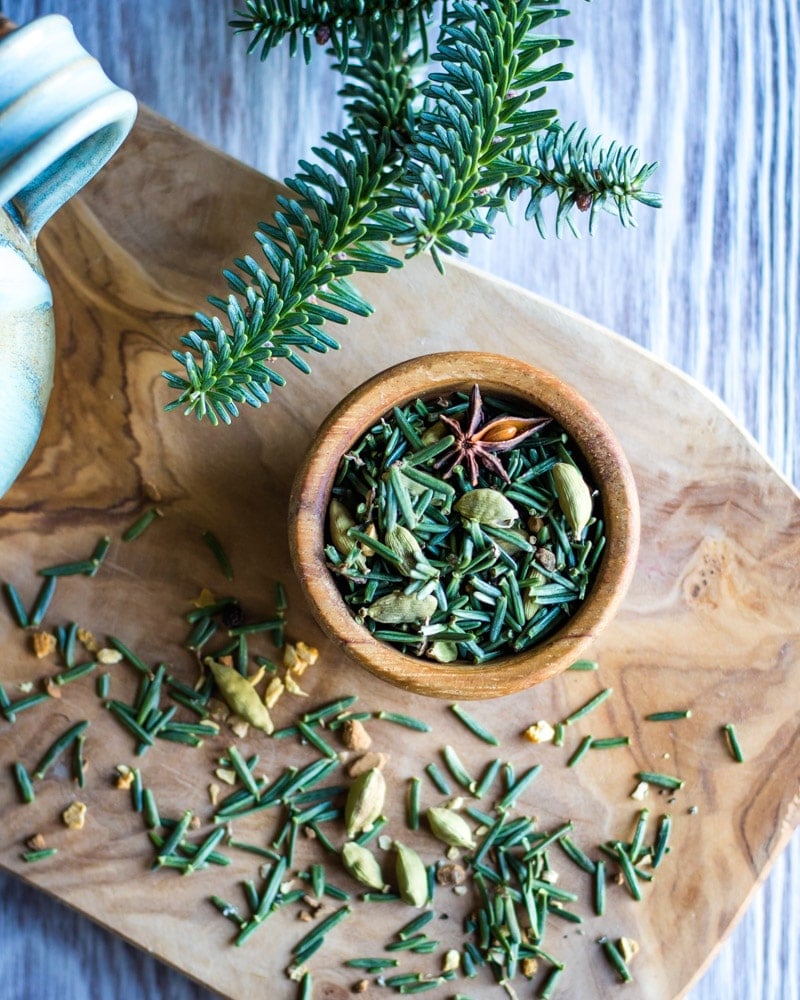
If you are using fresh needles I would make a smaller batch and use it up fairly quickly.
I also would not cap the jar, so that any moisture that might be there can escape. Fresh needles have more flavor and are really a joy to use!
In the springtime you can collect fresh fir tips and dry them for later use in this chai.
Brew a Cup of Fir Needle Chai
When you are ready to make the chai, steep one heaping tablespoon of the mixture in 8 to 10 ounces of near boiling water. Let the tea infuse for 5 to 7 minutes or longer if desired, then strain into a mug.
If you prefer a sweeter tea you can add a spoonful of raw honey if you wish. Try it without first, you may be pleasantly surprised by its flavor!
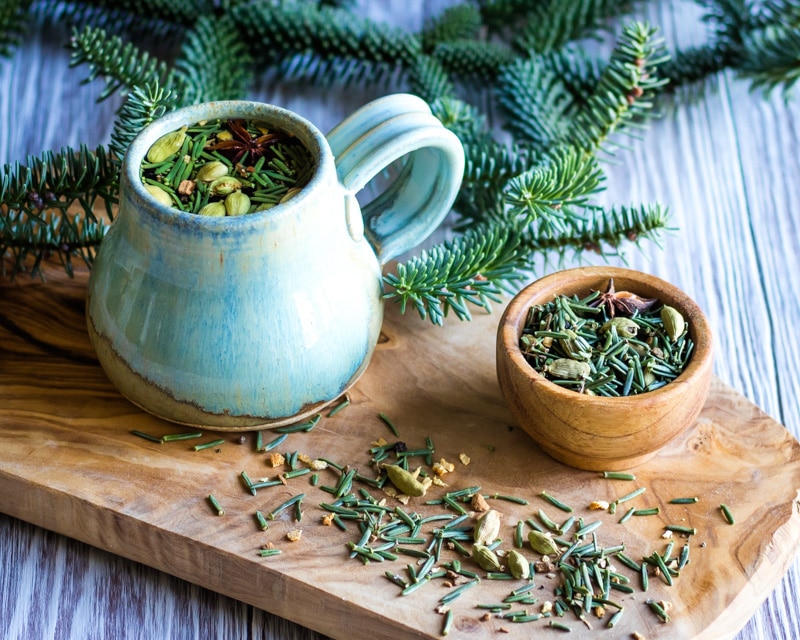
This conifer needle chai is definitely my new favorite wintertime drink!
For more delicious chai recipes, try homemade spicy chai or chaga chai with carob and coconut!
More Fir Needle Recipes
Fir Needle Forest Chai
Equipment
Ingredients
- 1 cup fir needles or tips dried or fresh
- 1 tbsp dried orange peel
- 1 tbsp cinnamon chips
- 1 tbsp green cardamom pods lightly crushed
- 1 tbsp star anise pods lightly crushed
- 1 tbsp dried ginger pieces
- 1/2 tsp black peppercorns lightly crushed
- raw honey to taste (optional)
Instructions
- Combine the fir needles, orange zest, cinnamon chips, cardamom pods, star anise pods, ginger, and peppercorns.
- If using dried fir needles, store in a jar with a tight fitting lid in a cool, dark place and use within one year. If using fresh fir needles, leave the jar open and use within a few weeks.
- To prepare the tea, steep one heaping tablespoon of the mixture in 8 to 10 ounces of near boiling water.
- Infuse for 5 to 7 minutes or longer if desired, then strain in a serving mug. Sweeten with raw honey if desired.

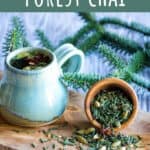
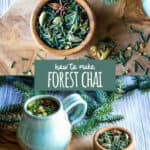

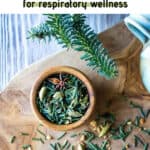
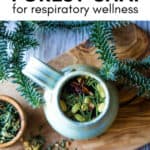
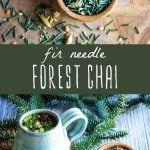
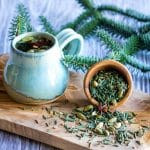

Could I substitute cardamom powder for the pods? And if so how much?
Hi there. I haven’t tried, so I can’t you give you an estimate on how much. If you want to experiment with it, let me know how it goes!
Absolutely lovely post! I am in love with that mug! Would you be able to share source for it? 🤗
Hi Kimberly! Thank you so much. I honestly can’t remember where I bought the mug, it may have been a lucky thrift store find!
Bean again… thank you for your response. could you use juniper berries in this tea or do you know a nice juniper berry blend to make for gifts. Thank you so much!!
Hi Beanie. Yes, you could totally add juniper berries to this recipe. Enjoy!
How long does it take to dry pine needles?
Pine needles contain very little water content, so no time at all. I typically use them fresh, including in this recipe.
The article mentions to dry for a week.
can you use spruce instead? just curious
Yes, of course.
Hi, I am interested to try this recipe. For the cardamom pods, do I use the entire pod and seed, once I slightly crush it, or remove the seed from the pod and just use the seeds?
Also, step 2 is referring to storage of pre-mixed ingredients, right?
Hi Arianne. You use the whole slightly crushed cardamom pod in the recipe. Step 2 is referring to how to store the fresh or dried pine needles themselves, however, you could store dried pine needles with the rest of the dried ingredients if you prefer. Personally, I store them all separately to preserve their individual flavors up until I make the chai.
Can you add this to black tea leaf and make an iced tea version?
Sure, that would work!
Douglas fir cones hang down, not up…my house is surrounded by them. Don’t want to confuse people.
Hi Ann, you are right that Douglas-fir cones hang down, but they are not true firs. Confusing, I know! You could still use Douglas-fir for this chai however, as they do have edible needles. To learn more see my post on identifying conifer trees.
How do I know it is not a Yew?
Would Douglas Fir needles be ok to use in this?
Yes, Douglas Fir would be fine for this. Any pine, spruce, or fir tree has edible parts, just be sure it is not a Yew since those are toxic.